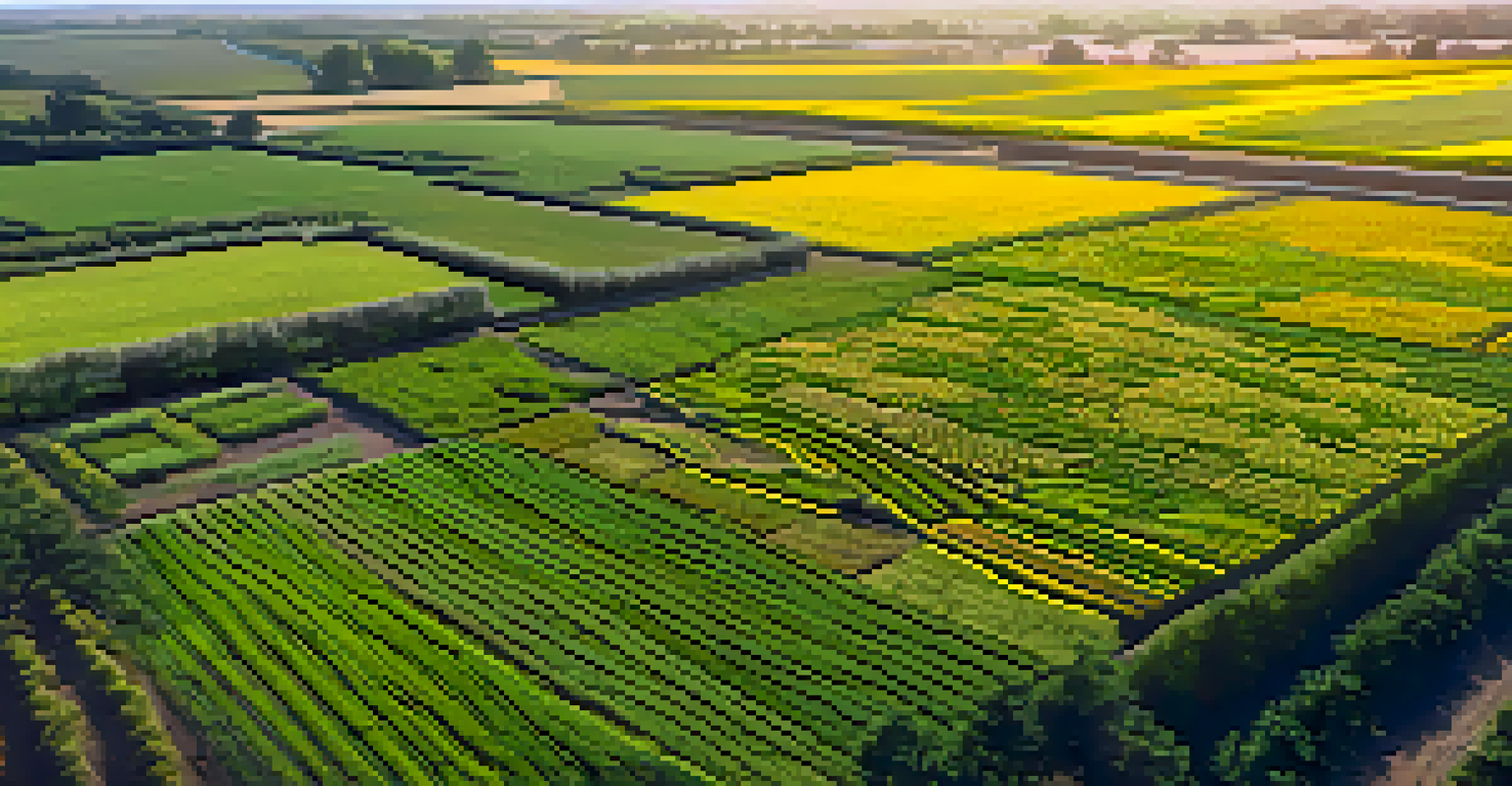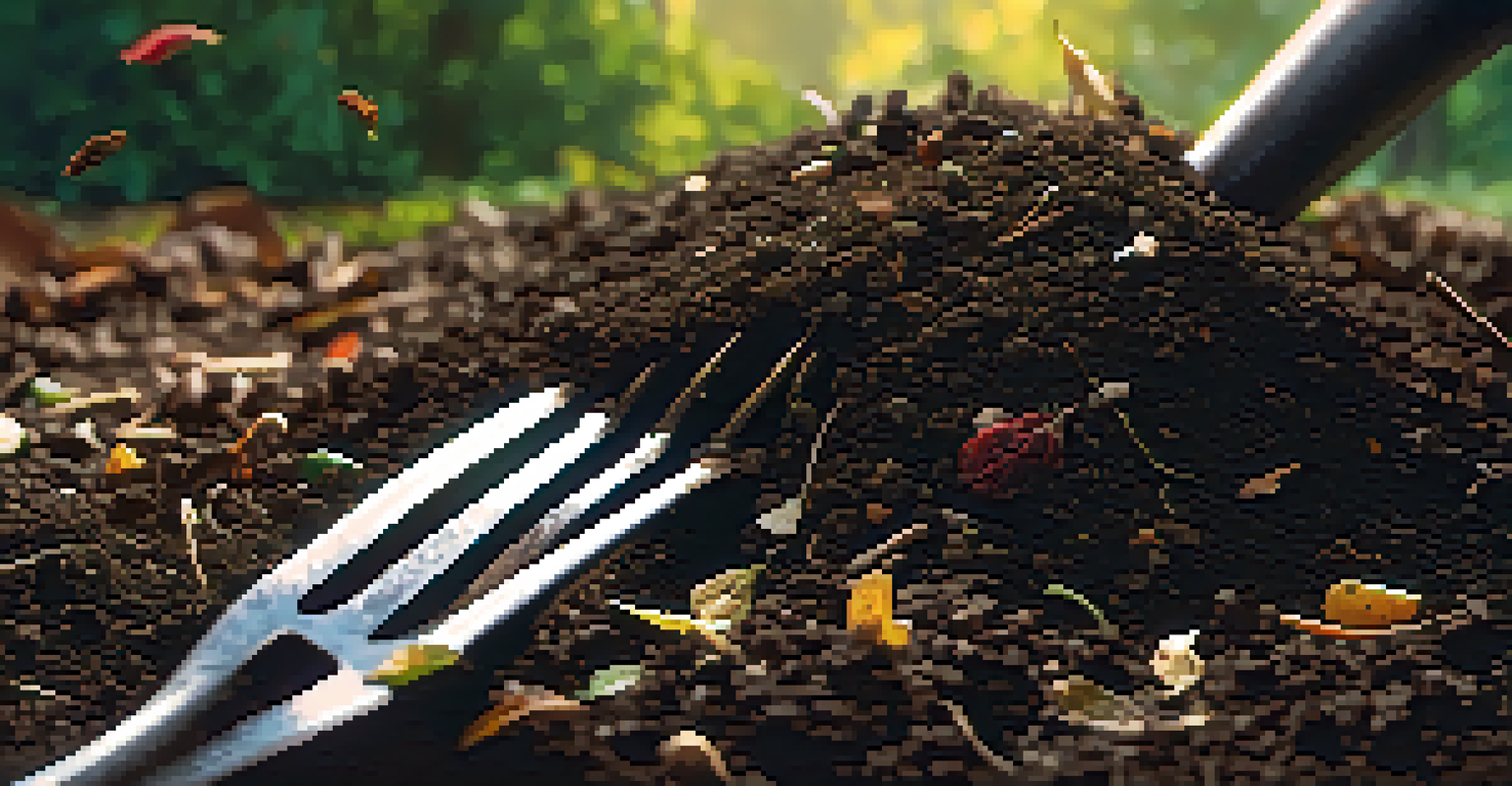Soil Health Management: Techniques for Sustainable Crop Production

Understanding Soil Health: The Foundation of Sustainable Farming
Soil health is often overlooked, yet it's the backbone of agriculture. It refers to the ability of soil to function as a living ecosystem, supporting plant growth, water filtration, and carbon storage. Healthy soil is rich in organic matter, nutrients, and beneficial microorganisms that contribute to crop productivity. By understanding soil health, farmers can make informed decisions that lead to sustainable farming practices.
Healthy soil is the foundation of healthy food.
Think of soil as a living organism; just like humans need a balanced diet, soil requires a mix of nutrients and organic material to thrive. Farmers who prioritize soil health often see increased yields and reduced need for chemical fertilizers. When soil is healthy, it not only supports crops but also enhances biodiversity and overall ecosystem resilience.
To get started, farmers can assess their soil health through tests that measure pH, nutrient levels, and organic matter content. This baseline information helps guide management decisions, ensuring that practices align with the specific needs of the soil and crops. Embracing this holistic view of soil can transform farming operations into more sustainable enterprises.
Cover Cropping: A Natural Way to Enhance Soil Quality
Cover cropping involves planting specific crops during the off-season to improve soil health. These crops, often legumes or grasses, help prevent soil erosion, suppress weeds, and enhance nutrient cycling. By planting cover crops, farmers can boost organic matter and improve soil structure, leading to healthier crops in the subsequent planting season.

For example, a farmer might plant clover or vetch after the main harvest. These cover crops not only protect the soil but also fix nitrogen, enriching the soil for future crops. This practice is like giving the soil a nourishing meal, allowing it to recover and build up its strength before the next planting.
Soil Health Supports Sustainable Farming
Prioritizing soil health enhances crop productivity, biodiversity, and ecosystem resilience.
In addition to these benefits, cover crops can also help improve water retention in the soil, making it more resilient during dry spells. When farmers adopt cover cropping as part of their soil health management strategy, they invest in the long-term productivity and sustainability of their land.
Crop Rotation: Diversifying for Soil Health Benefits
Crop rotation is a powerful technique that involves alternating different types of crops in the same area over time. This practice helps prevent the depletion of specific nutrients and reduces pest and disease cycles. By varying crops, farmers can break the cycles of pests and diseases that thrive on specific plants, making their fields healthier and more productive.
We cannot solve our problems with the same thinking we used when we created them.
Imagine planting corn one year, followed by soybeans the next. Corn exhausts certain nutrients, while soybeans can replenish them by fixing nitrogen in the soil. This natural partnership not only improves soil nutrient content but also enhances overall productivity, creating a system that's beneficial for both crops.
Moreover, crop rotation can help manage soil erosion and improve soil structure. By allowing different root systems to develop, farmers can encourage better soil aeration and water infiltration. This simple yet effective method can lead to increased yields and a more sustainable farming system.
Organic Amendments: Boosting Soil Fertility Naturally
Organic amendments, such as compost and manure, are invaluable for enhancing soil fertility and health. These materials add essential nutrients and improve soil structure, promoting better water retention and drainage. Using organic amendments is like giving your soil a nutrient-rich boost, fostering a thriving environment for crops.
For instance, incorporating well-rotted compost into the soil can improve its organic matter content, supporting beneficial microorganisms that help break down nutrients for plant uptake. This process enhances soil life and contributes to a sustainable cycle of growth and fertility.
Cover Cropping Enhances Soil Quality
Planting cover crops during the off-season boosts organic matter, prevents erosion, and improves nutrient cycling.
Additionally, organic amendments can help sequester carbon in the soil, playing a role in mitigating climate change. By choosing to amend soils organically, farmers not only enhance crop productivity but also contribute positively to their ecosystem and the planet.
Conservation Tillage: Protecting Soil from Erosion
Conservation tillage is a practice that minimizes soil disturbance, preserving soil structure and health. By reducing tillage, farmers can protect the soil from erosion, enhance water retention, and promote microbial activity. This approach allows for a more sustainable method of farming that aligns with the principles of soil health management.
Consider it this way: every time soil is tilled, it’s like stirring a delicate mix of ingredients in a cake batter. Too much stirring can ruin the texture. Similarly, excessive tillage can disrupt the soil's ecosystem, leading to nutrient loss and decreased productivity.
By adopting conservation tillage methods, such as no-till or reduced-till practices, farmers can maintain soil health while still achieving successful crop production. This balance between productivity and conservation is key to sustainable agriculture.
Integrated Pest Management: Protecting Soil and Crops
Integrated Pest Management (IPM) is an eco-friendly approach to pest control that considers the health of both crops and soil. By combining biological, cultural, and mechanical practices, farmers can manage pests while minimizing the use of chemical pesticides. This holistic method not only protects crops but also supports healthy soil ecosystems.
For instance, introducing beneficial insects, like ladybugs, can help control aphid populations naturally. This reduces the need for chemical interventions, preserving beneficial soil microorganisms that can be harmed by pesticides. It’s about finding that sweet spot between keeping crops healthy and maintaining soil integrity.
Education Drives Sustainable Practices
Community engagement and education empower farmers to adopt innovative soil health management techniques.
Additionally, monitoring pest populations and using targeted treatments can further reduce the environmental impact of pest management. By implementing IPM strategies, farmers contribute to a sustainable farming system that nurtures soil health and promotes biodiversity.
Soil Testing: A Key Component of Effective Management
Regular soil testing is crucial for effective soil health management. By analyzing soil composition, farmers can identify nutrient deficiencies and excesses, allowing for targeted amendments. This data-driven approach helps ensure that crops receive exactly what they need for optimal growth, making farming more efficient.
Think of soil testing as a health check-up for your soil. Just like a doctor assesses your health through tests, farmers can evaluate their soil’s condition and tailor their management practices accordingly. This proactive strategy not only enhances productivity but also supports sustainable practices.

Moreover, understanding soil health over time can help track the impact of different management practices. By adapting to the results of soil tests, farmers can continually improve their soil health management, leading to more resilient and productive farming systems.
Education and Community: Learning for Sustainable Practices
Education and community involvement play pivotal roles in advancing soil health management. Farmers can benefit significantly from workshops, seminars, and local agricultural extension services that provide valuable insights into sustainable techniques. Sharing knowledge within the farming community fosters a culture of collaboration and innovation.
Imagine a farmer attending a workshop on cover cropping and then sharing that knowledge with neighbors. This ripple effect can lead to widespread adoption of sustainable practices, enhancing the health of local soils and ecosystems. Communities that learn together can create a more resilient agricultural landscape.
Additionally, engaging with research institutions and universities can provide farmers access to the latest advancements in soil health management. By prioritizing education, farmers can stay informed and empowered to make choices that benefit both their crops and the environment.